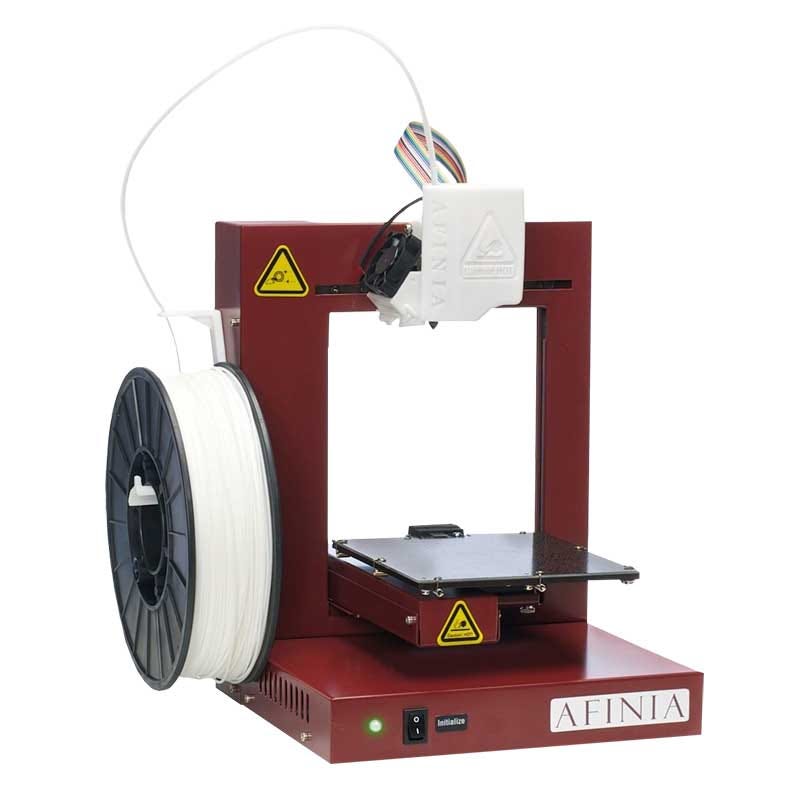The Stratasys vs Afinia court clash
Today, all eyes are on Bambu Lab, but 10 years ago, it was Afinia who fought off
On August 8, 2024 — exactly on the 40th anniversary of the official invention of 3D printing — representatives of Stratasys filed two lawsuits in the US District Court for the Eastern District of Texas.
These lawsuits concerned the infringement of 10 patents in the field of 3D printing technology. The suits were directed against five Chinese companies, which are reportedly united under a single brand — Bambu Lab.
This event caused a huge stir in the global 3D printing industry!
The sentiment is, that Bambu Lab, a company beloved by everyone for producing super-fast, super-efficient, and relatively inexpensive desktop FDM/FFF 3D printers, became the target of the powerful Stratasys, which, using patents obtained by some cunning, intends to destroy the bastion of manufacturing freedom.
Bambu Lab has become Mr. Robot, and Stratasys has become E Corp. This cannot be questioned.

Well, there are some who do question it anyway, accusing “Chinese companies” in general of doing the same thing. One such person is, for example, Josef Průša.
But currently, the most popular and appropriate stance is to side with Bambu Lab.
It is well known that every common 3D printing Chinese company by default supports freedom and liberty — both in the area of additive manufacturing and in other areas of life.
Naomi Wu confirms this.
But let’s leave that for the moment…
I would like to tell you about something else. Something that happened 10 years ago and had the same significance as today. Both in market terms and ideologically.
Back then, Stratasys also intended to “murder free 3D printing.” To „crush the 3D printing community worldwide with a heavy corporate boot”.
Similarly to today, its victim was supposed to be a small, likable Chinese company that almost no one remembers today (despite still existing).
10 years ago, Stratasys sued Afinia
It all began in the last days of November 2013. Stratasys — one of the leaders in industrial 3D printing — sued Microboards Technology, LLC, the company behind the increasingly recognizable and popular desktop 3D printer brand, Afinia.
However, the case was much more complicated:
Microboards Technology was the distributor of Afinia in the USA.
Afinia was just a name under which a completely different brand of 3D printers was offered.
That brand of 3D printers was Up!
Which was developed and produced by the Chinese company TierTime.
At that time, TierTime posed a real threat to Stratasys both in the area of cheap 3D printers (the subject of the lawsuit) and expensive, industrial machines (the Inspire series).
It is also worth remembering that in November 2013, Stratasys:
Had only been a product of the merger between the American Stratasys and Israeli Objet for two years.
Stratasys was mainly responsible for FDM technology, while Objet for PolyJet technology (Solidscape, a company responsible for 3D printing wax parts, was also acquired in the background).
Six months earlier, Stratasys acquired the world’s largest producer of desktop 3D printers — MakerBot.
In any case, in November 2013, Stratasys sued Microboards. The company was accused of infringing four patents:
US5653925A — Method for controlled porosity three-dimensional modeling (expired in 2015)
US5866058A — Method for rapid prototyping of solid models (expired in 2017)
US6004124A — Thin-wall tube liquifier (expired in 2018)
US8349239B2 — Seam concealment for three-dimensional models (active — expires on 28.02.2031).
The first patent was the most controversial as it concerned the percentage setting of infill in 3D prints. It was a patent that everyone was violating at that time.
The second patent concerned a heated build platform, the third an extruder (specifically the use of tubes to guide the filament to the 3D printer’s head), and the fourth methods of creating/concealing so-called seams on 3D prints.
As is the case today with Bambu Lab, the contested patents back then affected all 3D printer manufacturers worldwide, but for some reason, Stratasys singled out only one.
Afinia.
And similarly to today, most of the patents were already quite old and could have been used earlier. But they were only used at the end of 2013.
Let’s recall what the FDM/FFF 3D printer market looked like back then:
In the industrial machine market, there was one main player — Stratasys, the inventor of FDM technology.
It was competing with the Chinese TierTime, the producer of Inspire 3D printers.
In the desktop and amateur market, the leaders were:
MakerBot (part of Stratasys since May 2013)
Cubify (a brand created by 3D Systems)
Afinia / Up! (a brand created by TierTime)
Ultimaker
LulzBot (Aleph Objects)
Solidoodle
Just emerging from the first Kickstarter deliveries: Printrbot and Robo 3D.
One interesting fact and one related question…
Fact:
Cubify (3D Systems) offered two 3D printers: Cube and CubeX. The latter (larger) was a development of the design from BitsFromBytes — a British company acquired by 3D Systems in 2010. But Cube was simply a Chinese Up! in an attractive plastic casing with dedicated filament cartridges.
Question:
Why then did Stratasys sue Afinia, even though 3D Systems was clearly using identical technology and was a direct competitor in the US market?
The answer to this question can only be speculative… The fact is that Stratasys did not sue 3D Systems.
What happened next?
We waited over a month for Afinia’s response. On January 2, 2014, the company launched a counterattack, claiming that:
it had not infringed on Stratasys’ patents,
Stratasys’ patents were invalid due to prior art, and that there were patents that preceded those of Stratasys,
Afinia would counterclaim for patent misuse on the part of Stratasys.
Furthermore, Afinia petitioned the court for a jury trial.
Then Afinia struck again at the end of the month, adding that:
they had evidence that Stratasys was using its patents to monopolize the market,
they had evidence that Stratasys failed to show the Patent Office one of its own patents that undermined the novelty of a new patent it was applying for,
they had evidence that Stratasys failed to show the Patent Office one of its own 3D printers that undermined the novelty of another new patent it was applying for.
As a result, in August 2014, Stratasys was forced to drop one of the infringement claims — the patent US-5653925A, which described controlling the infill of a 3D printed part. Afinia proved that a patent for that process had already been granted in the past, meaning that this new patent, granted to Stratasys in 1997, should be considered invalid.
On December 22, 2014 (over a year after the lawsuit was filed), Afinia announced that it had commenced Inter Partes Review of the asserted Stratasys patents at the U.S. Patent Office. Afinia claimed that the asserted patents were both invalid and not infringed.
Six months later, on June 12, 2015, Stratasys announced that it had successfully defended the validity of its FDM patents.
I don’t think that was the original goal of its lawsuit, but either way — they managed to do it!
In September 2015, during the trial, the court was to determine the validity of the contested patents, which essentially boiled down to the grammatical interpretation of individual words used in the descriptions of the inventions.
But simultaneously, both parties began trying to reach a settlement…
On October 15, 2015, the companies filed a request for the sixth (yes, sixth!) modification of the Court’s pre-trial schedule. In the filing, Stratasys and Afinia explained that they were engaged in active settlement discussions and wanted the opportunity to focus on reaching an amicable resolution in the coming weeks, rather than wasting time and resources on completing expert disclosures.
On October 27, 2015, the settlement was reached. On that day, exactly 701 days had passed since the lawsuit was filed in court.
The case was officially closed six months later, on June 13, 2016.
What was achieved?
As part of the settlement, Afinia agreed to make some adjustments to its 3D printers. The thing is, by the turn of 2015 and 2016, the company’s position was already far from what it had been in 2013.
Yes, the “3D printing” train moves so fast…
At the beginning of 2016, the market looked completely different than it did in November 2013.
In the industrial machine market, there was still one main player — Stratasys.
TierTime had significantly declined in the rankings.
New companies had emerged that were soon to become much bigger threats to Stratasys: Markforged, Roboze, BigRep, Intamsys, and many, many others.
In the desktop and amateur market, the leaders were:
MakerBot (without Bre Pettis on board),
Ultimaker (which was about to present the groundbreaking Ultimaker 3),
Zortrax (with its brilliant M200),
LulzBot,
Robo 3D.
And of the previously mentioned competitors:
Cubify was dead,
Afinia / Up! was a shadow of its former self,
Solidoodle was soon to be dead (mid-2016),
Printrbot was struggling (pronounced dead in 2018).
So Stratasys achieved that Afinia did indeed soon disappear from the horizon (though it didn’t cease to exist!), but in its place, many new companies emerged that became incomparably stronger than Afinia ever was.
They achieved the fact that their patents (which had either expired by the time the dispute ended or were about to expire soon after) were upheld by the court.
They spent a lot of money on lawyers (the case lasted a total of two and a half years).
To be honest — I’m not entirely convinced that it was all worth the cost…?
Returning to today
Listen, I didn’t describe how the patents were contested one by one because they are no longer valid (except for one), and it didn’t have much impact on the story itself.
The reason I’m describing all this is to, in light of past events, view the current Stratasys vs. Bambu Lab dispute in a broader way.
First of all — this case is going to drag on for a long time.
Secondly — it will cost both sides a lot of money.
Thirdly — we know how much money Stratasys has (because it publishes quarterly financial reports), but we don’t know how much the group of Chinese companies sued under the moniker “Bambu Lab” has.
Fourthly — so we don’t know who might benefit more from dragging the dispute out over time.
Fifthly — Stratasys recently announced a move. They will be renting spaces and putting their own up for sale. Does that sound like a company with plenty of money to burn?
And finally, sixthly… I hope that the folks at Stratasys are learning from their mistakes.







